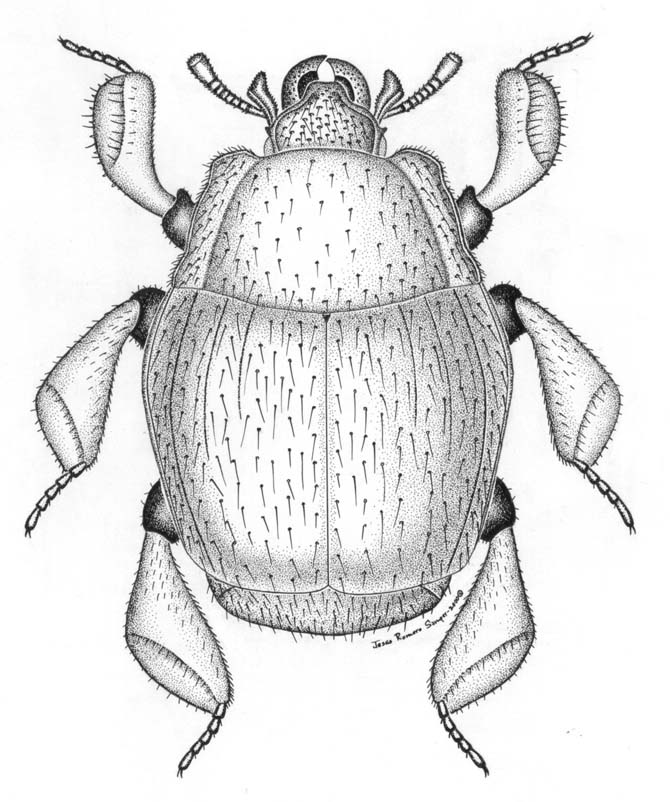
Sternocoelis berberus Lackner et Yélamos, 2001
Sternocoelis berberus Lackner et Yélamos, 2001: 100 [Morocco].
Description
Colour reddish brown, shiny, weakly convex, oval; dorsal surface with sparse and long yellow setae, ventrally these setae are shorter.
Frons wide, with dense and long setae; frontal stria cariniform, evanescent on epistoma; labrum slightly depressed; mandibles large, convex and finely punctulate; eyes distinct; antennae pubescent; antennal scape very enlarged, with an internal hook very characteristic; antennal club very enlarged, cylindrical.
Pronotum smooth, only with setigerous foveae and long yellow setae; sides well separated from the disc, explanate; marginal stria complete; anterior angles truncate, not elevated; posterior angles not produced. Elytra weakly convex, with setigerous foveae and very long setae, lacking punctuation; first dorsal stria complete, well impressed; second stria fine and longer than the half length of the elytra; third stria very fine, only reaching the middle; outer subhumeral and marginal striae well impressed, complete, joined on the apical 2/3; an epipleural stria well impressed, only interrupted on the base.
Propygidium and pygidium very long, convex, with very long yellow setae.
Prosternal keel depressed, finely punctulate, setose, with inner striae cariniform, separated on the base and parallel in the remaining surface, suddenly approximate apically, not joined; outer prosternal striae cariniform, diverging apically; prosternal lobe at lower level than the keel, rugose and setose. Mesosternum smooth, without lateral foveae; meso-metasternal excavation deep. Metasternum only with sparse puncticules, sparsely setose, with 3 oblique striae, the inner reaching the middle, sides with more setae.
First abdominal sternite smooth, with long and fine setae, with lateral striae very oblique, complete.
Legs relatively short, strong, densely setose and very expanded.
Eighth abdominal segment of male, spiculum gastrale and aedeagus with the common morphology of the genus. Eighth abdominal segment of male wide and slightly sclerotized. Spiculum gastrale very fine and short, Y-shaped. Basal piece of the aedeagus short and wide; parameres wide, relatively short, distally separated.
Length: 1,4 - 1,6 mm. Width: 1,2 - 1,3 mm (males smaller than females)
Type series
Holotype, male labelled "MAROCCO centr. Haut Atlas, 25.4.95, Tizi-n-Tichka env., T. Lackner leg., 2.100 m". In T. Lackner collection.
Paratypes, 1 male and 1 female labelled as the holotype, in T. Lackner Coll. and T. Yélamos Coll. 47 specimens labelled "MAROC central, HAUT ATLAS, 2800 m, OukaÅEeden region, 19-20.V.2000, T. Lackner leg. 40 specimens in T. Lackner Coll., 6 specimens in T. Yélamos Coll. and another in J. de Ferrer Coll. 3 specimens labelled "MAROC, Grand Atlas central, Plateau d'Oukaimeden, 2650 m, 3.V.83, dans nid d'Aphaenogaster testaceopilosa", 2 specimens in Y. Gomy Coll. and another in P. Ponel Coll.
Etymology
The name of this new species "berberus" is adopted from the origin of the people inhabiting the High Atlas mountains, the Berber people.
Diagnosis
The present new species belongs to the group with the sides of pronotum clearly separated from the disc by a complete oblique impression, and prosternal lobe at lower level of keel. In this group it seems to be related to St. laevidorsis (Fairmaire, 1976) from Algeria and Tunisia, but clearly distinguished from this species by: size, colour, puncturation, setae, antennal scape, prosternal keel, metasternal striae, elytral surface... On the other hand, excepting the pronotal sides explanate, in the remaining characteristics it ressembles very much to St. marseulii (Brisout de Barneville, 1866) from Spain (also the antennal scape with a "hook"). Maybe they are closely related. Without any doubt, the new species is one of the most easily distinguishable species from Morocco.
Comments
Up to now this species is only known from the High Atlas region (Morocco), Tizi-n-Tichka (Taddert) at 2.100 m, and Oukaimeden, 2.800 m, in nests of an uknown species of ants, on clay soils.
According to our records this is the first Sternocoelis known from the High Atlas. The Sternocoelis have many species in northern Morocco (also in the Middle Atlas) and Algeria, but up to now in the High Atlas only had records of Eretmotus (E. alluaudi).

Figure 1. Male habitus of Sternocoelis berberus sp. n.
Distribution. Morocco.